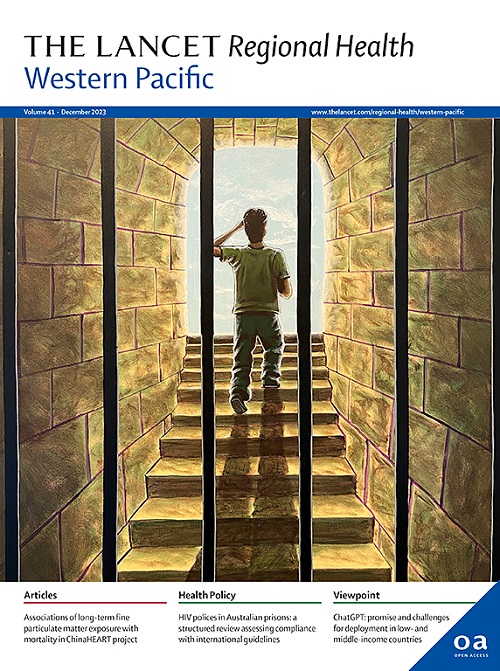新辅助奇达胺联合化疗治疗激素受体阳性、人表皮生长因子受体2阴性乳腺癌(MUKDEN 05):一项多中心、单臂、2期试验
IF 8.1
1区 医学
Q1 HEALTH CARE SCIENCES & SERVICES
引用次数: 0
摘要
现有的激素受体阳性、人表皮生长因子受体2阴性(HR+/HER2−)乳腺癌的新辅助治疗尚未取得最佳临床结果,因此需要研究新的治疗策略。鉴于HDAC抑制剂在晚期乳腺癌治疗中的新意义,本研究探讨了奇达胺联合化疗作为HR+/HER2−乳腺癌患者新辅助治疗的有效性和安全性。方法该单臂、开放标签、多中心、2期临床试验在中国3家医院进行。纳入年龄18-75岁的treatment-naïve II-III期HR+/HER2 -乳腺癌患者,东部肿瘤合作组评分为0-1。患者在每个21天周期的第1、4、8和11天口服剂量为20mg的奇达胺。化疗方案包括表柔比星(90 mg/m2)和环磷酰胺(600 mg/m2)每3周给药4个周期,然后每3周给药4个周期多西紫杉醇(100 mg/m2)。主要终点为残余癌症负担率(RCB) 0 - 1。本研究已在ClinicalTrials.gov注册,编号NCT05400993。研究结果:在2022年5月23日至2023年7月6日期间,共招募了54名女性患者(中位年龄:50岁[范围,26-75岁])。RCB 0-I率为35.2%(19 / 54,95%可信区间[CI], 22.7%-49.4%)。最常见的3级或4级不良事件是中性粒细胞计数减少(70%)和白细胞减少(67%)。无治疗相关死亡发生。解释:奇达胺联合化疗有可能成为HR+/HER2−乳腺癌患者的新辅助治疗选择。沈阳市科技计划(批准号:22-321-32-18),深圳晶屏生物科技有限公司本文章由计算机程序翻译,如有差异,请以英文原文为准。
Neoadjuvant chidamide combined with chemotherapy in patients with hormone receptor-positive, human epidermal growth factor receptor 2-negative breast cancer (MUKDEN 05): a multicentre, single-arm, phase 2 trial
Background
Existing neoadjuvant therapies for hormone receptor-positive, human epidermal growth factor receptor 2-negative (HR+/HER2−) breast cancer have not achieved optimal clinical outcomes, thus prompting the investigation of novel treatment strategies. Given the emerging significance of HDAC inhibitors in the management of advanced breast cancer, this study investigated the efficacy and safety of chidamide plus chemotherapy as neoadjuvant therapy for patients with HR+/HER2− breast cancer.
Methods
This single arm, open-label, multicentre, phase 2 trial was conducted at three hospitals in China. Patients aged 18–75 years who had treatment-naïve, stage II–III HR+/HER2− breast cancer with an Eastern Cooperative Oncology Group performance status of 0–1 were enrolled. Patients received oral chidamide at a dose of 20 mg on days 1, 4, 8, and 11 of each 21-day cycle. The chemotherapy regimen consisted of four cycles of epirubicin (90 mg/m2) and cyclophosphamide (600 mg/m2) administered every three weeks, followed by four cycles of docetaxel (100 mg/m2) administered every three weeks. The primary endpoint was the rate of residual cancer burden (RCB) 0–I. This study is registered with ClinicalTrials.gov, NCT05400993.
Findings
Between May 23, 2022 and July 6, 2023, a total of 54 female patients (median age: 50 years [range, 26–75]) were recruited. The RCB 0–I rate was 35.2% (19 of 54, 95% confidence interval [CI], 22.7%–49.4%). The most frequent grade 3 or 4 adverse events were decreased neutrophil count (70%) and decreased white blood cell (67%). No treatment-related deaths occurred.
Interpretation
The combination of chidamide and chemotherapy shows the potential to be an alternative neoadjuvant therapy option for patients with HR+/HER2− breast cancer.
Funding
Shenyang Municipal Science and Technology Program (Grant No. 22-321-32-18), Shenzhen Chipscreen Biosciences Co., Ltd.
求助全文
通过发布文献求助,成功后即可免费获取论文全文。
去求助
来源期刊

The Lancet Regional Health: Western Pacific
Medicine-Pediatrics, Perinatology and Child Health
CiteScore
8.80
自引率
2.80%
发文量
305
审稿时长
11 weeks
期刊介绍:
The Lancet Regional Health – Western Pacific, a gold open access journal, is an integral part of The Lancet's global initiative advocating for healthcare quality and access worldwide. It aims to advance clinical practice and health policy in the Western Pacific region, contributing to enhanced health outcomes. The journal publishes high-quality original research shedding light on clinical practice and health policy in the region. It also includes reviews, commentaries, and opinion pieces covering diverse regional health topics, such as infectious diseases, non-communicable diseases, child and adolescent health, maternal and reproductive health, aging health, mental health, the health workforce and systems, and health policy.
 求助内容:
求助内容: 应助结果提醒方式:
应助结果提醒方式:


